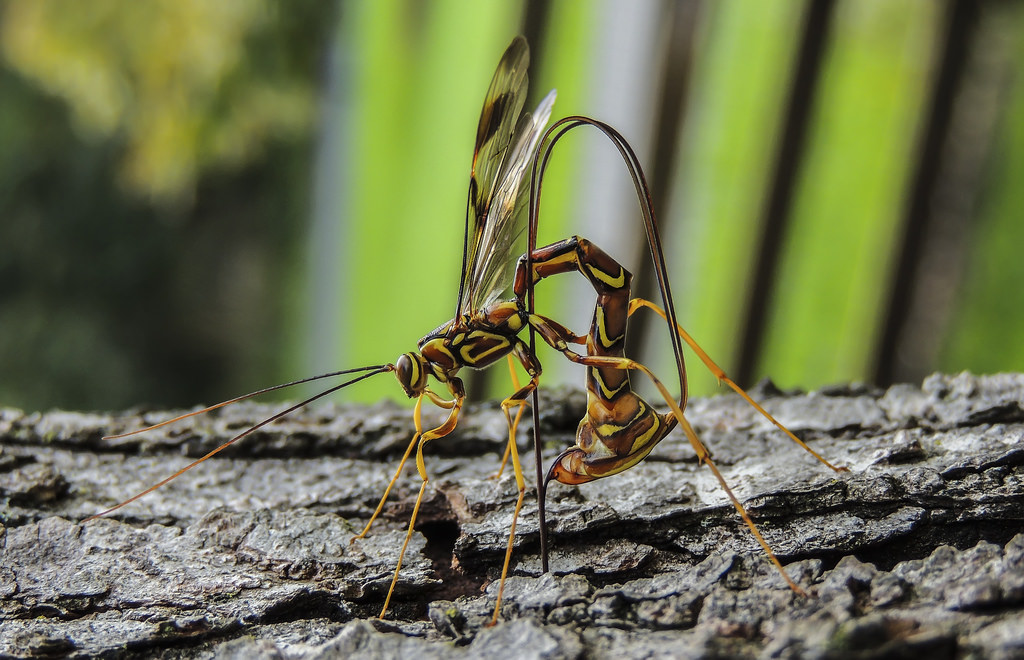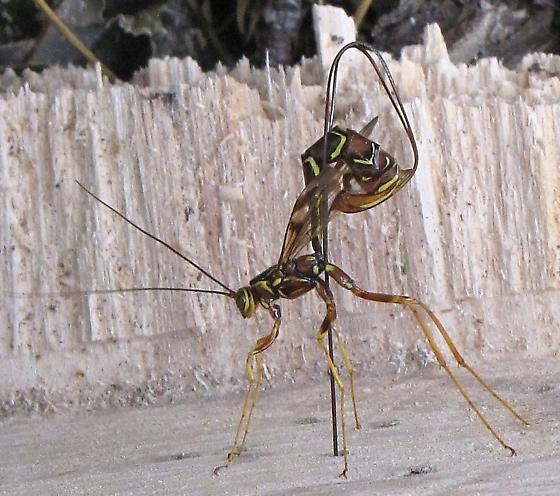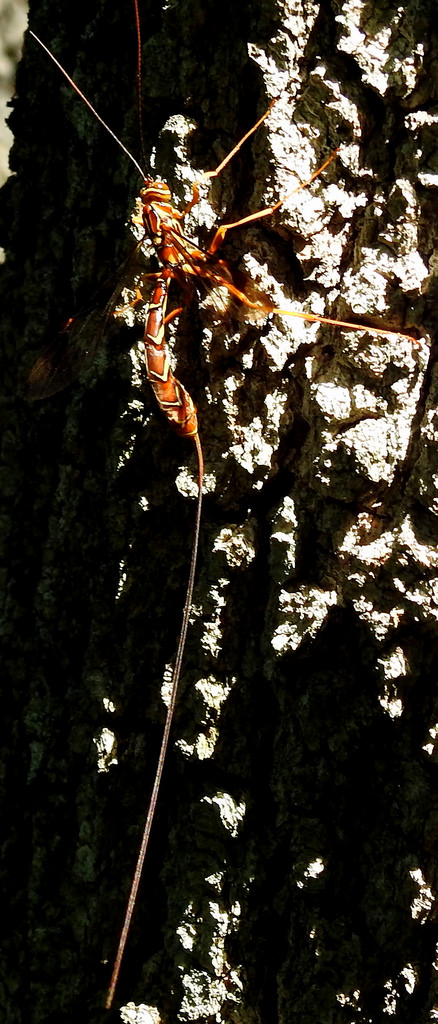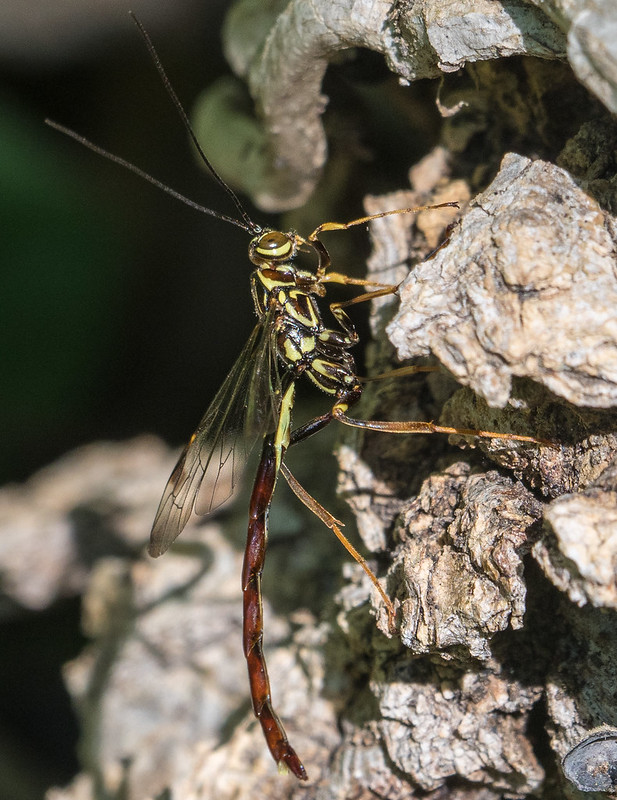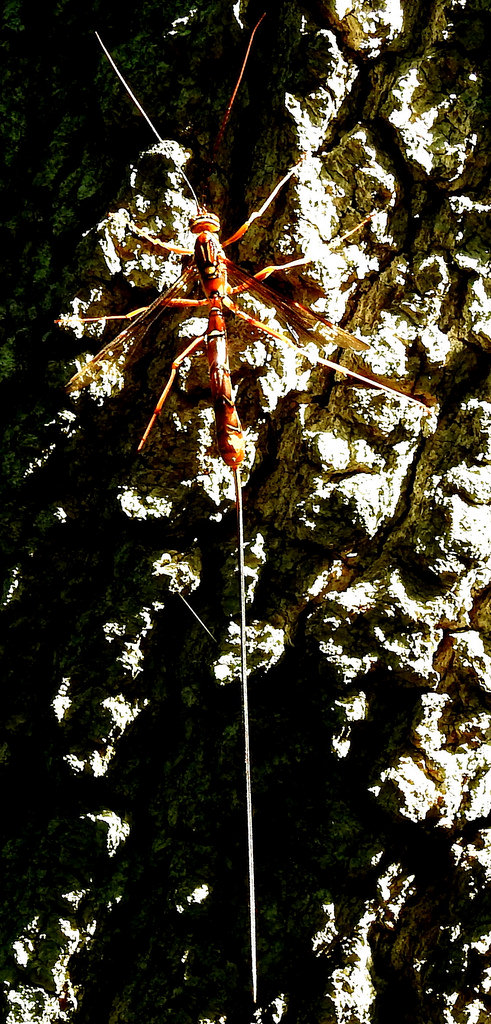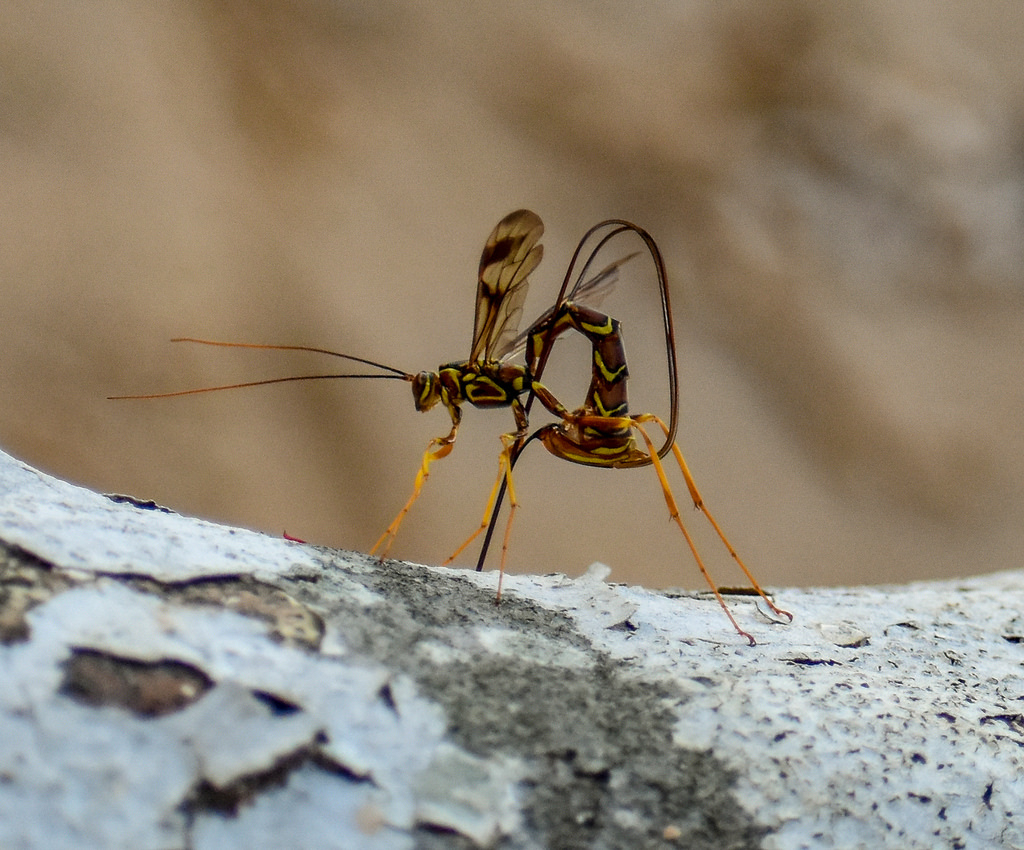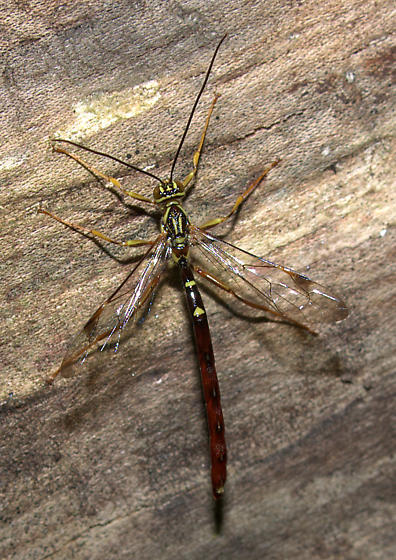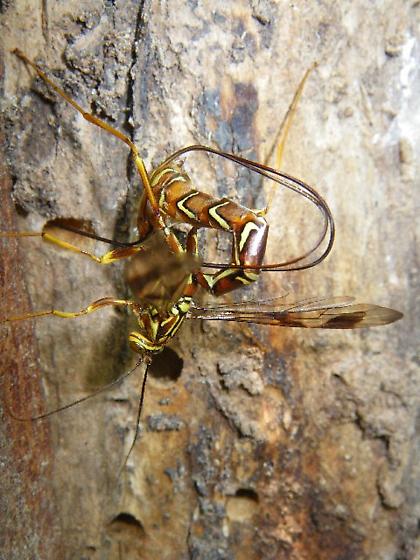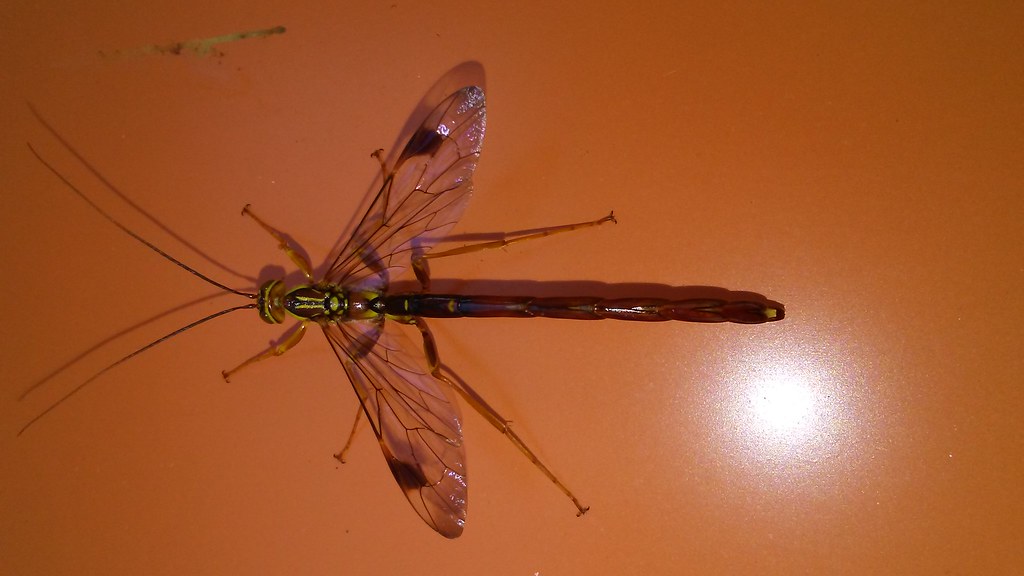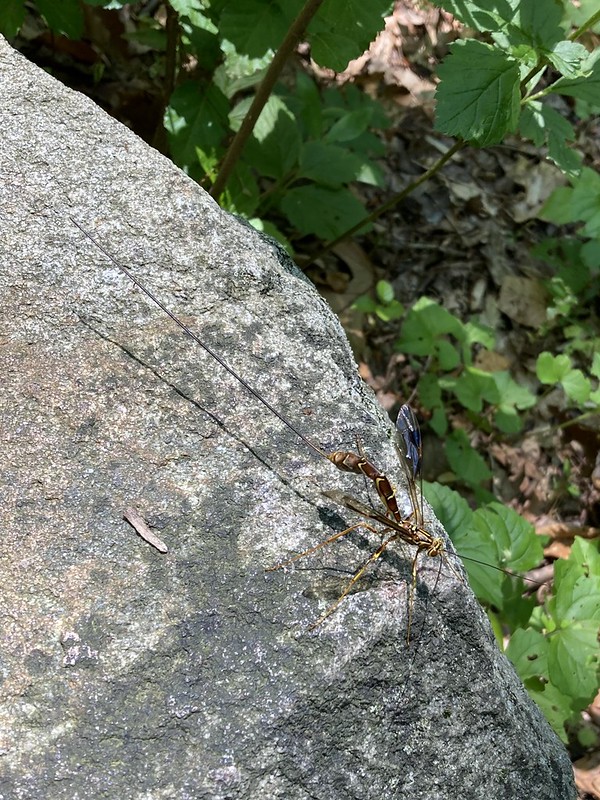Map Snapshot









11 Records
Seasonality Snapshot
Source: Wikipedia
| Megarhyssa macrurus | |
|---|---|

| |
| Pair of females, with individual at left ovipositing | |
| Scientific classification | |
| Domain: | Eukaryota |
| Kingdom: | Animalia |
| Phylum: | Arthropoda |
| Class: | Insecta |
| Order: | Hymenoptera |
| Family: | Ichneumonidae |
| Subfamily: | Rhyssinae |
| Genus: | Megarhyssa |
| Species: | M. macrurus
|
| Binomial name | |
| Megarhyssa macrurus (Linnaeus, 1771)
| |
Megarhyssa macrurus, also known as the long-tailed giant ichneumonid wasp[1] or long-tailed giant ichneumon wasp,[2] is a species of large ichneumon wasp.[3] It is a parasitoid, notable for its extremely long ovipositor which it uses to deposit an egg into a tunnel in dead wood bored by its host, the larva of a similarly large species of horntail.
Etymology
[edit]The specific epithet of macrurus is from the Greek words makrós (μακρός) meaning "long", and oùrá (οὐρά) meaning tail.[4]
Description
[edit]Megarhyssa macrurus has a reddish-brown body of up to 2 inches (51 mm) long.[5] It has black and yellow-orange stripes.[6] Its wings are transparent and the body elongated. The body and ovipositor together can be more than 5 inches (130 mm) long in the female. Males are smaller and have no ovipositor.[6]
The ovipositor
[edit]The ovipositor looks like a single filament, but it comprises three filaments, the middle one of which is the actual ovipositor, which is capable of drilling into wood. This central filament also appears to be a single filament, but is made of two parts, with a cutting edge at the tip. The two parts interlock and slide against each other.
Although very thin, the ovipositor is a tube and the egg being laid moves down a minute channel in its center. The outer two filaments are sheaths which protect the ovipositor; they arc out to the sides during egg-laying.[6]
Distribution
[edit]M. macrurus is found across the eastern half of the United States, reaching into the extreme south of Canada near the Great Lakes.[7]
Behaviour
[edit]
M. macrurus is harmless to humans;[6][8] they are parasitoids on the larvae of the pigeon horntail (Tremex columba, Symphyta), which bore tunnels in decaying wood.[9] Female Megarhyssa macrurus are able to detect these larvae through the bark; they paralyse them and lay their eggs on the living but paralysed larva; within a couple of weeks the Megarhyssa larvae will have consumed their host and pupate, emerging as an adult the following summer.[6]
Subspecies
[edit]- M. m. icterosticta Michener, 1939
- M. m. lunator (Fabricius, 1781) - considered a synonym of M. m. macrurus by Carlson (1979)[10][12]
- M. m. macrurus (Linnaeus, 1771)
References
[edit]- ^ Cresswell, Stephen (2020). "Megarhyssa macrurus, Long-tailed Giant Ichneumonid Wasp". American Insects. Retrieved 2020-06-04.
- ^ "Long-Tailed Giant Ichneumon Wasp". MDC Field Guide. Missouri Department of Conservation. Retrieved 2020-06-04.
- ^ Ichneumonid wasp, Megarhyssa macrurus (Hymenoptera: Ichneumonidae). Insectimages.org (2010-05-04). Retrieved on 2010-12-17.
- ^ Species Megarhyssa macrurus. BugGuide.Net. Retrieved on 2010-12-17.
- ^ "Giant Ichneumon Wasp: Long-tailed (Megarhyssa macrurus)". Insect Identification for the Casual Observer. 2019. Retrieved 2020-06-04.
- ^ a b c d e Pigeon Tremex Horntail and the Giant Ichneumon Wasp. Ext.colostate.edu (2010-05-12). Retrieved on 2010-12-17.
- ^ "Megarhyssa macrurus". Discover Life; Global Biodiversity Information Facility. Retrieved 10 July 2017.
- ^ "Ichneumon wasp". Archived from the original on 2010-12-10. Retrieved 2010-12-14.
- ^ Ichneumon wasp Archived 2010-12-10 at the Wayback Machine. Insects.tamu.edu. Retrieved on 2010-12-17.
- ^ a b Pook, Victoria; Sharkey, Michael; Wahl, David (2016-01-04). "Key to the species of Megarhyssa (Hymenoptera, Ichneumonidae, Rhyssinae) in America, north of Mexico". Deutsche Entomologische Zeitschrift. 63 (1): 137–148. doi:10.3897/dez.63.7619. ISSN 1860-1324.
- ^ Essig Museum of Entomology Collections. Essigdb.berkeley.edu. Retrieved on 2010-12-17.
- ^ Carlson, Robert W. (1979). "Family Ichneumonidae". In Krombein, Karl V.; Hurd, Paul D. Jr.; Smith, David R.; Burks, B.D. (eds.). Catalog of Hymenoptera in America North of Mexico. Vol. 1. Smithsonian Institution Press. pp. 354–355.
